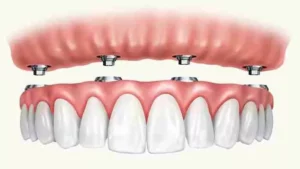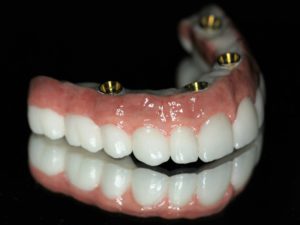
Upper arch implants are dental implants for the upper jaw. This article explains what they are, how they work, their benefits, and the procedure involved.
Key Takeaways
- Upper arch implants provide a stable, long-lasting solution for missing teeth, enhancing oral function and aesthetics while preventing jawbone deterioration.
- The procedure involves multiple stages, including an initial consultation, surgical placement, and a healing phase known as osseointegration, which is essential for the implants’ success.
- The benefits of upper arch implants include improved stability and functionality, enhanced aesthetics and confidence, and significant long-term oral health advantages compared to traditional dentures.
Understanding Upper Arch Implants
Upper arch implants serve as a foundation for various prosthetics solutions, enhancing oral function and aesthetics. These implants are strategically placed in the upper jaw to support a full arch of prosthetic teeth, providing a stable and long-lasting alternative to traditional dentures.
What Are Upper Arch Implants?
Upper arch implants are titanium anchors designed to secure a full arch prosthesis, such as a denture, bridge, or hybrid arch. They replace the roots of missing teeth, providing a strong foundation for prosthetic teeth that look and function like natural teeth. This full-arch restoration typically involves placing four dental implants in the upper jaw, though the number can vary based on individual needs. The outcome is a functional, natural-looking replacement for missing teeth, which helps maintain facial structure by preventing jawbone deterioration.
The consequences of losing an entire arch of upper teeth can be severe, including jawbone deterioration, shifting of remaining teeth, and changes in facial features. Upper arch implants are surgically anchored in the lower jaw, providing better stability and functionality compared to traditional dentures that sit on the gums. This can affect both the upper or lower jaw.
Implant-supported dentures come in two types: removable dentures and permanent, providing options based on patient preference.
How Do Upper Arch Implants Work?

Digital full arch implant systems provide improved accuracy and efficiency in the initial assessment, reducing chair time for patients. During the procedure, the dentist uses advanced imaging techniques to plan the placement of the implants, ensuring they integrate well with the jawbone. This meticulous planning is crucial as the final prosthesis placement occurs only after sufficient healing and osseointegration of the implants.
Osseointegration is the process where the implants fuse with the jawbone, creating a stable foundation for the prosthetic teeth. This phase is critical for the long-term success of the implants, allowing them to function like natural teeth. Older adults can also benefit from upper arch implants as age alone is not a limiting factor.
The Procedure for Upper Arch Implants
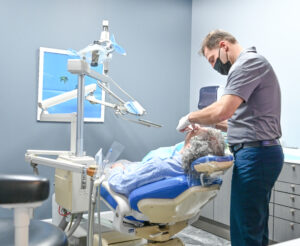
Initial Consultation and Assessment
The initial consultation is the first step in the entire process. During this visit, the dentist will evaluate your oral health to determine your suitability for implants. Imaging and scans may be performed to assess the condition of your gums and bone density.
Additionally, your medical history will be reviewed to verify there are no contraindications for the procedure.
Surgical Placement of Implants
The next step involves the surgical placement of the implants. The oral surgeon makes a small incision in the gum tissue to place the dental implants into the jawbone. Local anesthesia is commonly used, though sedation or general anesthesia can be provided if needed. Post-surgery, patients are advised to take prescribed pain relief medications promptly to manage discomfort effectively.
To reduce swelling, applying ice packs intermittently for the first 24 hours is recommended. NSAIDs like ibuprofen are often suggested for pain management. Following these guidelines can significantly ease the recovery process and ensure the implants settle properly.
Healing and Osseointegration
The healing phase, known as osseointegration, is crucial for the stability of the dental implant. This process typically lasts three to nine months, during which the implants integrate with the jawbone. Proper oral hygiene during this period is essential, including gentle brushing and flossing to prevent infection and promote healing.
Osseointegration ensures the implants are firmly anchored in the jawbone, providing a stable foundation for the final prosthesis. This phase requires patience and adherence to dental care instructions to achieve the best results and prevent complications such as bone loss or infection.
Benefits of Upper Arch Implants
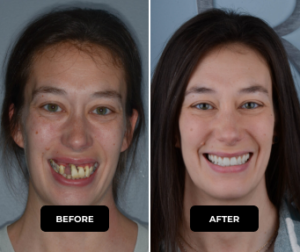
Improved Stability and Functionality
Upper arch implants provide a secure fit that allows for a more natural bite. Unlike traditional dentures, implant-supported dentures do not require adhesive to stay in place and eliminate the risk of slipping.
This stability makes chewing and speaking easier, offering a significant improvement in daily functionality.
Enhanced Aesthetics and Confidence
Full arch dental implants restore a natural-looking smile, significantly boosting a person’s self-confidence. Unlike partial dentures, which can leave gaps, full arch implants provide a comprehensive solution that mimics the appearance of natural teeth, enhancing overall aesthetics.
Achieving a complete attractive smile restores the ability to smile, chew, and talk confidently with the mouth.
Long-Term Oral Health Benefits
Implant-supported dentures significantly reduce the risk of bone loss in the jaw, contributing to long-term oral health. By preserving bone density, upper arch implants prevent the deterioration that can occur with traditional dentures, leading to lasting improvements in oral health. For those concerned about osteoporosis and dental implants, learn what you need to know.
Maintaining oral health is crucial for overall wellbeing, and upper arch implants play a significant role in this.
Candidates for Upper Arch Implants
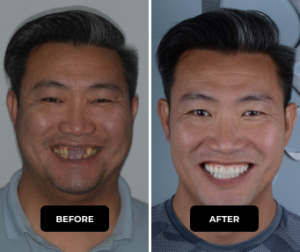
Candidates often report an improvement in social interactions and self-image after receiving upper arch implants, which can help them respond more positively in social situations.
Health and Bone Density Requirements
Adequate bone tissue structure is crucial for the successful integration of upper arch implants. If bone density is low, a dentist may recommend using five to six four implants instead of the standard four. Evaluations often involve imaging techniques to assess bone mass and determine the best approach for the implants.
Age Considerations
Older adults can benefit from upper arch implants, as age alone does not restrict the success of this dental solution. Maintaining good oral health can be more challenging as we age, but with proper care, upper arch implants can be an effective option.
There is no upper age limit for receiving implants; patients in their 80s and 90s can successfully undergo the procedure.
Comparing Upper Arch Implants with Other Options
When comparing upper arch implants with other dental solutions, it’s clear that they offer superior stability, functionality, and long-term benefits, creating a solid bond.
Implant-supported dentures provide a more stable and comfortable alternative compared to traditional and partial dentures.
Upper Arch Implants vs. Traditional Dentures
Upper arch implants provide the highest level of stability and functionality compared to traditional dentures. Traditional dentures can often move or slip during use, leading to discomfort and difficulty in chewing and speaking. In contrast, implant-supported dentures offer greater stability and do not require adhesives, providing a secure and comfortable fit.
Moreover, upper arch implants stimulate bone and prevent bone loss, leading to better long-term maintenance compared to traditional dentures. This preservation of bone density is crucial for maintaining facial structure and overall oral health.
Upper Arch Implants vs. Partial Dentures
Upper arch implants provide enhanced stability, allowing for improved chewing and speech compared to traditional partial dentures. The stability offered by upper arch implants minimizes the risk of slippage, leading to a more comfortable experience.
Additionally, upper arch implants blend seamlessly with natural teeth, providing enhanced aesthetics and boosting self-confidence. They also prevent bone loss, maintaining jawbone density and contributing to long-term oral health.
Post-Operative Care for Upper Arch Implants
Maintaining good oral hygiene and following post-operative care instructions are vital for the longevity and success of upper arch implants. Proper care can lead to enhanced oral health and the durability of the implants over time.
Managing Discomfort and Swelling
Post-operative care instructions are essential for a successful recovery after upper arch implants. Some discomfort and swelling are expected during recovery, but these can be managed using prescribed pain medication and ice packs.
Taking medication as prescribed and applying ice packs intermittently can significantly ease the recovery process.
Dietary Recommendations
A soft diet during the healing period is crucial to facilitate recovery after upper arch implant surgery. Patients should adhere to a strictly soft diet immediately following surgery to avoid complications.
After the healing process, patients can gradually reintroduce regular foods into their diet.
Maintenance and Hygiene
With proper care, implant-supported dentures can last a lifetime. They are specifically designed for longevity. Full arch dental implants require minimal maintenance compared to traditional dentures, which need regular upkeep. During the healing phase, it is important to stick to a soft diet. Patients can gradually reintroduce a regular diet as they recover, eventually returning to normal eating habits.
Regular dental check-ups are crucial to ensure the longevity and health of upper arch implants. These check-ups help monitor the condition of the implants and address any potential issues promptly, ensuring the implants remain secure and functional.
Cost and Financing Options for Upper Arch Implants
Understanding the cost and financing options for upper arch implants is essential for making an informed decision. Various factors influence the cost, and there are multiple financing options available to make the investment more manageable.
Factors Influencing Cost
The cost of upper arch implants is influenced by factors such as the type of implant, the number of implants needed, and the geographic location. Although upper arch implants may have a higher upfront cost compared to traditional dentures, the long-term benefits can justify the investment.
The cost per dental implant for a single tooth varies. It can be a few thousand dollars.
Financing and Insurance
Yes, insurance may cover a portion of the expenses associated with upper arch implants, providing more extensive benefits than initially thought. Dentists often offer financing options that can help patients manage the cost over time, making the process more affordable and less stressful.
Understanding financing plans and insurance coverage can make acquiring upper arch implants more manageable, providing a comprehensive guide to make this dental solution accessible.
Finding a Qualified Implant Dentist
Choosing a skilled and experienced dentist for upper arch implants is crucial for a successful outcome. It’s important to consider the dentist’s qualifications, experience, and patient reviews to ensure you receive the best possible care.
Credentials and Experience
Look for dentists who have completed specialized training and hold certifications from recognized implantology boards. A dentist’s experience is crucial; inquire about their specific number of implant procedures performed annually. Some dentists may primarily focus on one aspect of the implant process, which can lead to complications if not managed properly.
Patient Reviews and Testimonials
Reading patient review and testimonials is essential for gauging the quality of care at a dental practice. Positive testimonials can indicate higher patient satisfaction and successful treatment outcomes.
Utilizing patient feedback can help you make a more informed decision when selecting a dental practice for upper arch implants.
Summary
Upper arch implants offer a comprehensive solution for those looking to restore their smile and improve their oral health. From the initial consultation to the final restoration, the procedure encompasses several stages that are crucial for ensuring the stability and longevity of the implants. The many benefits of upper arch implants, including improved stability, functionality, aesthetics, and long-term oral health, make them a superior choice compared to traditional and partial dentures.
For those considering upper arch implants, it’s essential to understand the costs and financing options available, as well as how to find a qualified implant dentist. With proper care and maintenance, upper arch implants can provide a lasting solution that enhances your quality of life. Embrace the journey to a brighter smile and better oral health with upper arch implants.
Frequently Asked Questions
What are upper arch implants?
Upper arch implants serve as titanium anchors that replace missing tooth roots, providing a stable foundation for full arch prosthetics like dentures or bridges. They ensure that the prosthetic teeth function and appear similar to natural teeth.
How do upper arch implants work?
Upper arch implants provide a stable base for prosthetic teeth by surgically placing implants into the jawbone, which later fuse with it during a healing phase called osseointegration. This process ensures a strong support system for restoring function and aesthetics.
What are the benefits of upper arch implants?
Upper arch implants provide enhanced stability and functionality while significantly improving aesthetics and boosting confidence. Additionally, they contribute to long-term oral health by preventing bone loss and mimicking the appearance of natural teeth.
Who are the ideal candidates for upper arch implants?
The ideal candidates for upper arch implants are individuals with significant tooth loss who possess adequate bone structure and overall health, which are essential for the implants’ success.
How can I find a qualified implant dentist?
To find a qualified implant dentist, seek professionals with specialized training and certifications from recognized implantology boards. Additionally, reviewing patient testimonials can offer valuable insights into their quality of care.

